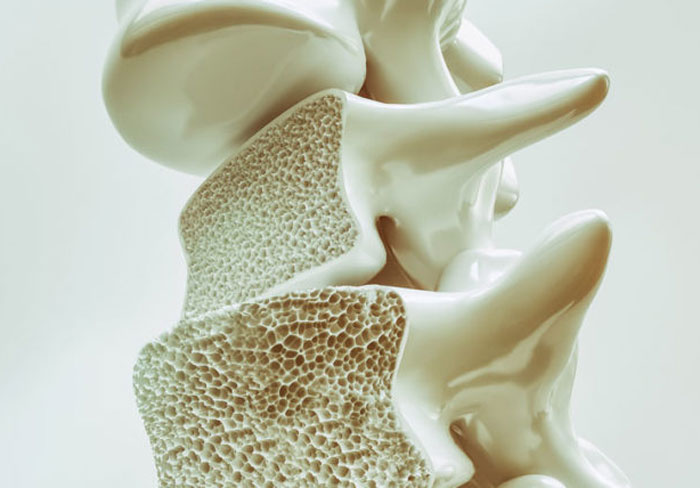One of the most common diseases that people of different ages deal with is osteoporosis. You may remember how much your parents insisted on eating healthy foods and drinking milk when you were a teenager. This type of silent disease is seen more with age, but the person suffering from osteoporosis may not know his illness. What is the cause of osteoporosis, and how is treated?
Stay with us; being aware of these critical points can prevent complex problems in old age with a simple fall.

What Is Osteoporosis?
Maybe you have heard about the word osteoporosis but don’t know its exact meaning. What is osteoporosis? It is a condition where the bone is weakened or brittle. Bone fragility means bending, slight pressure, falling, and even coughing can cause bones to break.
What Are The Causes and Factors Affecting Osteoporosis?
The bones of the body are constantly changing. These changes, which include the breakdown of old bone and the replacement of new bone, occur more rapidly at a young age. But over time, it slows down, and as a result, more bones are lost in the body. Therefore, the cause of osteoporosis can depend on genetic factors or the amount of bone mass formed in youth.
Various factors may cause, including:
-
Natural and Uncontrollable Factors
Some factors that cause this disease, such as age, gender, race, family history, bone structure, etc., are out of your control. This means that you do not have a significant role in its creation! For example, you may develop osteoporosis due to genetic reasons, or you have often heard that it is more common in women than in men. You may also be at risk if any family member has suffered from osteoporosis.
-
Hormone Levels
Sometimes the cause of osteoporosis is increased or decreased certain hormones in the body. Among the hormones that lead to osteoporosis, we can mention the following:
-
Sex Hormones
A decrease in estrogen levels in women and a decrease in testosterone levels in men may cause osteoporosis in them.
-
Thyroid
Thyroid hypofunction or hyperfunction is another factor that leads to osteoporosis.
-
Other Glands
the activity of adrenal glands and hyperthyroidism are also closely related to this disease.
-
Diet
Having a healthy diet can prevent many diseases. However, low calcium intake, appetite disorders, and gastrointestinal surgery such as stomach and intestine can be influential factors.
-
Steroids and Drugs
Suppose a person uses corticosteroid drugs for a long time or some medications for seizure problems, gastric reflux, cancer, or organ transplant drugs. In that case, he is more prone to developing osteoporosis.
-
Medical Problems
If a person suffers from celiac disease, intestinal inflammation, kidney or liver disease, cancer, lotus, joint rheumatism, multiple myeloma, etc., the risk of osteoporosis will be higher.
-
Lifestyle
Some bad habits in life may lead to osteoporosis. For example, smoking, high alcohol consumption, and a sedentary lifestyle reduce bone density in the body, and as a result, they are among the factors of osteoporosis.
Problems and Treatments
Most common Symptoms
Unfortunately, in its early stages, osteoporosis does not have any specific symptoms, progresses silently in the body, and can only be diagnosed with accurate medical tests. But some people may have symptoms after the bones weaken. Some of the hidden signs of osteoporosis that may be seen in different people are:
- Back pain after fracture
- Loss of height over time
- Easier breaking of bones
- stooped
- sudden insomnia
- Gum diseases
- Loosening of teeth
- Nocturnal leg cramps
- Having brittle nails
- Having disorders in grasping some objects

Methods of diagnosing
Unfortunately, diagnosing osteoporosis is impossible until at least 30% of the bones have been lost in conventional imaging such as radiography. For this reason, bone densitometry is used to diagnose osteoporosis. In this test, various areas, such as the hip bone, spine, etc., are scanned using X-rays. This test is painless and involves a scanner that passes over your body. All you have to do is sit in a chair or lie on a bed and wait for your bone density to be checked by the scanner.
What are the treatment methods for osteoporosis?
To treat osteoporosis, comprehensive information must first be collected about the individual’s condition because a specific treatment method is chosen according to each individual’s situation. If the patient’s bones are thin and weak, the doctor may want to check for a fragility fracture, known as a soft fracture. In examining an open fracture, the specialist doctor considers the following:
- Age
- BMI
- Family history of hip fracture
- Do you smoke or not?
- Do you suffer from other diseases, such as rheumatoid arthritis?
- Measurement of bone density by X-ray scan
Non-surgical methods are usually used to treat. Some of these methods are:
-
Use of bisphosphonates
Most drugs prescribed to treat osteoporosis are usually from the phosphonate family. Although side effects such as nausea, abdominal pain, and heartache have been observed in the study of these drugs, if you take them correctly, you will not face any severe problems. Bisphosphonate drugs used to treat osteoporosis include alendronate, risedronate, ibandronate, and zoledronic acid.
-
Use of monoclonal antibody drugs
Another method of treating osteoporosis is denosumab, which can create better bone density than bisphosphonate. However, the side effects of this type of drug are severe, and if you start using it, you will have to continue it for a very long time, and you will not be able to stop it or replace it with another drug. Note that if you stop taking this medicine, you may have a fracture of the spine. Also, you will not be allowed to pull your teeth while using this medicine. Therefore, you should visit the dentist before starting the treatment period and ensure your teeth’ health and take good care of your teeth during the treatment period.
-
Hormone replacement
As mentioned above, reducing some hormones, such as estrogen and testosterone, can cause osteoporosis. Therefore, it is possible to treat this problem by using drugs that have the same function as these hormones and can mimic their role. Raloxifene is usually used to replace these hormones, but its side effects may include the risk of blood clots and flushing.
-
Bone-building drugs
If the patient cannot be treated with the usual osteoporosis treatment methods, the doctor can use teriparatide (Forteo), abaloparatide (Tymlos), and romosozumab. Of course, we must mention that these drugs can only be used for one or two years.
-
Sport
The good news for some people with osteoporosis is that they can reduce their osteoporosis symptoms by exercising and doing some exercises at home. Training may also be influential in improving bone density and preventing osteoporosis. Therefore, take the effect of exercise in maintaining body health seriously.
-
Physiotherapy
As you know, physiotherapy includes movements and exercises used to treat various diseases. Physical therapy can help build strong, healthy bones. Usually, the activities and actions that are performed for each person are different because the selection of these exercises depends on various factors, including:
- Cause of osteoporosis
- One’s body fitness level
- A person’s tolerance level
- The risk of vertebral bone fracture in a person
What to do to prevent osteoporosis?
As with any disease, osteoporosis is much easier to prevent than to cure. Fortunately, prevention of this disease is very easy and can be done with a few simple measures. Some of these measures include:
- Physical activity and mobility
- Eating healthy foods
- Fitness
- Not smoking
- Being fully aware of your situation
- Taking supplements to prevent osteoporosis
- Drinking 2 to 3 cups of tea a day
- Prevent depression
Researchers believe that depression causes a decrease in bone density and there is a direct relationship between depression and a decrease in bone density. Therefore, if you suffer from depression, be sure to visit a specialist doctor to control your bone density in addition to treating it.





